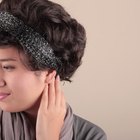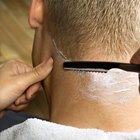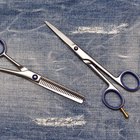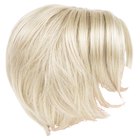
Synthetic wigs are made with plastic fibers that mimic the look, feel and movement of real hair. They can be a fun fashion statement every now and then or a great daily choice for those who can't grow the style they desire. When cutting a long synthetic wig short, every snip counts--remember, it's not going to grow back, ever. For the most foolproof cut, start with a one-length bob without layers or angles. Use tools and styling products (including scissors, brushes and sprays) that are specially designed for synthetic hair to achieve the most natural-looking results.
Step 1
Choose a wig with straight long hair that feels similar to natural hair. A straight-hair wig will be easier to cut than a curly wig, since the hair falls smoothly and allows you to create a cleaner line. Curls, both real and synthetic, can stretch and compress depending on how the hair is styled, making it more difficult to cut the hair evenly.
Step 2
Fit the wig onto the head of the person who will wear it. Drape a towel or cutter's cape around the person's neck and shoulders to catch falling hair. If it's your wig, fit it snugly onto a foam head stand that is very similar in size and shape to your own head to ensure that the wig will suit your head and face shape. Hold the wig in place on the head stand with t-pins inserted at the front crown and sides of the wig.
Step 3
Brush the hair smooth. Spritz the hair from roots to tips with a wig detangler or refresher to remove any knots and then smooth misshapen hair. Part the hair as it will be worn.
Step 4
Section the hair into 1-inch to 1 1/2-inch vertical sections all around the head. Secure each section with a stylist clip so that you can focus on one section at a time.
Step 5
Decide on the final length for the cut. It may be useful to use the chin as a guide, which will give you a "landmark" to help you to gauge the length of the hair and cut each section uniformly. The chin-length bob is a classic haircut that suits a variety of face shapes.
Step 6
Angle your scissors upward, about 30 degrees lower than vertical. Cutting into the wig, rather than cutting it straight across, will remove some volume from the ends and create a more natural line.
Step 7
Begin cutting the first section to the right of the face. At first, trim the section 1 to 2 inches longer than the final length you want your wig to be. Take small, careful snips, cutting no more than several strands of hair with each cut. The smaller the section, the less severe the cut and the more natural your wig will look. Comb through the hair with a wig comb after each snip and monitor the length to make sure it suits the face shape of the wearer. If it is your own wig, you may want to try it on after your initial cut to make sure the length suits your face shape. Once you decide on a length that suits you, reposition it on the foam head, pin and continue.
Step 8
Trim the section carefully up to your desired length, using small snips at a 30 degree angle. You can always cut more hair, but if you accidentally cut a section shorter than you intended, you will have to cut the rest of the wig to match. The most important part of cutting a synthetic wig is making sure that each section of hair blends with the rest of the wig.
Step 9
Trim the section to the left side of the face to match the first section you trimmed. Leave the trimmed section down and release the next section of hair to the left from its clip. Carefully trim so that it blends with the first section. If the ends appear unnaturally severe, position the scissors more vertically and snip into the bottom quarter inch of the ends of the hair. This will release a little more weight and soften the ends.
Step 10
Move to the right side of the head and trim the section next to your first section. Blend carefully with the first section. Continue trimming sections alternately on the left and right until you finish the final section at the back of the head. Alternating sections will help to ensure that one side of the wig does not end up significantly shorter than the other side. Comb through each section as you work to make sure the hair is smooth and even.
Step 11
Brush the entire wig smooth and check for any pieces of hair that escaped the scissors. From this point, you can determine if you want to add layers, bangs or angle the hair so that either the front or back of the wig is slightly shorter to suit the face shape and preference of the wearer. Remember that these subtle change are more difficult to trim and blend evenly. If you want something very particular you may want to consult a wig stylist to further modify your wig.
Related Articles

How to Cut Bangs Into a Bob Wig

How to Make Wigs Look Natural

How to Make Headband Wigs

How to Do a Taper Fade

How to Cut Piecey Hair

How to Cut Thinning Hair

How to Highlight Wigs

How to Trim a Beard to a Point

How to Texturize Bangs With Scissors

How to Cut Your Own Hair Short for ...

How to Keep Ends of Braids Closed

Haircuts for Men With Big Foreheads

How to Take the Frizz Out of a ...

How to Comb Out a Play Wig

How to Cut Curly Bangs

How to Apply Lace Wigs With No Tape or ...

How to Cut Chinese Bangs

How to Make Bangs With Glue in Hair ...

How to Take Care of a Synthetic Wig

What Do the Numbers on Hair Clipper ...
References
- Headcovers Unlimited: How to Care for Your Wig
- Wearing a Wig: How to Style Synthetic Wigs
- The Four Most Common Haircuts That Anyone Can Master; Lisa Marie Scozzari
Writer Bio
Lindsey Robinson Sanchez, from Bessemer, Ala., has written for the "Troy Messenger," "The Alabama Baptist" and "The Gainesville Times," where her work was featured on the AP wire. She has a Bachelor of Science in journalism from the University of Florida. She writes style, beauty, fitness, travel and culture.
Photo Credits
Agri Press/Lifesize/Getty Images